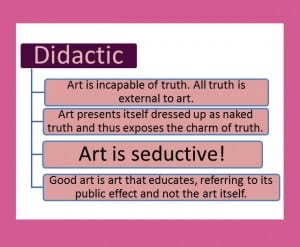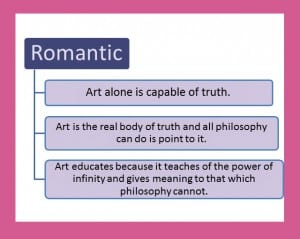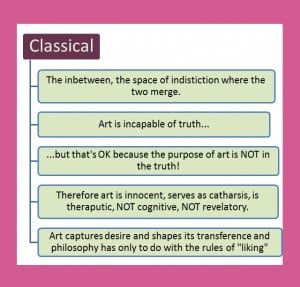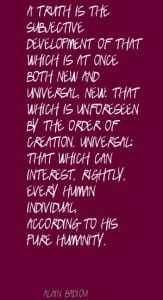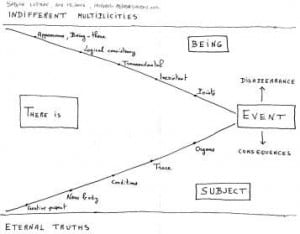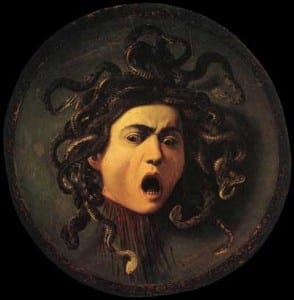ALAIN BADIOU
HANDBOOK OF INAESTHETICS
Reading Badiou I have come to the conclusion that he is way to concise and well written to enable any sort of summary without leaving out crucial details. Every word he writes is necessary! I found myself however making interesting associations with previous readings but also with some of my own beliefs… It is those that I intend to focus on mostly even if in a “short and sweet” manner, as I believe that anyone can get hold of the text and read it but the products of each individual’s post reading reflections are unique and have perhaps something to offer…
Chapter 1 – Art and Philosophy
Keywords: art, philosophy, oscillation, didactic, romantic, classic, likelihood – “verisimilitude”, Brecht, hermeneutics, psychoanalysis, singularity, immanence, configuration, truth, education, idolatry, censure, mimesis, desire, object of desire, Deleuze.
Badiou begins my reminding us that the relationship of art and philosophy has always been that of an oscillation, a back and forth, a never-ending loop… He describes art as the key to education and speaks of Lacan’s theory of the Master and the Hysteric as a relation parallel to that of philosophy and art. Just as the Hysteric challenges the Master in asking him to define her and always remaining disappointed by his responses and asking for more and more, so does art always challenge philosophy, constantly questions its answers as to her identity…
He then continues to analyze the three possible schemata linking art and philosophy, the didactic, the romantic and the classical, and the relationship each attributes to art and the truth…
These two rules of “liking” state that art must be liked. However that has nothing to do with opinion but simply with art’s cathartic effect. Furthermore, it has nothing to do with truth either, it only needs to resemble truth within the imaginary, to touch upon the spectator’s desire. It is what Badiou calls likelihood or verisimilitude, proposing that the truth is not always that which is likely and giving philosophy the “role” of the unlikely truth. Quoting: “Art is not a form of thought, it completes its existence simply by its act.”
Coming to the 20th century, the author speaks of the saturation of all three aforementioned tendencies and their characteristic examples:
- Brecht and the didactic schema, where art is the peoples’ service producing no truth but only guidance against cowardice in the face of truth.
- Hermeneutics and the romantic schema where art is an element of pure promise, and one and the same truth circulates between art and philosophy.
- Psycthoanalysis and the classical, with Freud and Lacan and the Aristotelian approach to self-consciousness conveyed by a theory of desire. Here a work of art depicts the blockage of the symbolic by the Real, the effect of art is imaginary and makes the object of desire emerge. I this schema only is it that we find a link of art to all the realms, symbolic, imaginary, real…
He describes the avant-garde’s failure to link art and philosophy in a persuasive fashion due to their tendency towards representation rather than thought. By condemning art as inauthentic and at the same time insisting that in must be reborn as absolute they were both didactic and romantic and they were neither… They were simply anti-classical…
The need arises now for a 4th schema, to bring us out of the saturated depths of the other three…It demands:
- To be rid of previous concepts on the relation of art and truth
- To find a way to make the relationship between art and truth at once singular and immanent, to show that art is both unique in its approach of truth but also takes place only within the mind of the subject, only within the truth it generates and has no place out of it.
Furhtermore:
- Art itself = a truth procedure.
- The philosophical identification of art can be categorized as truth
- Art is a thought in which artworks are the Real.
- Art cannot be reduced to philosophy.
- All art makes clear is its own existence.
- Philosophy guides us in our encounters with the truth. (can we say it lives in the in between state? Where what is and what is not truth merge and need clarification?)
- Art produces truth and education is the arrangement of knowledge so that some truth may come to pierce a hole in it and make us go further; therefore art is pedagodical.
- A work of art is finite, it is complete in its existence and anything done to it afterwards is potentially catastrophic.
In order to give a work of art the ability to be a truth we have to demote the infinite nature of truth to meet the finite nature of art. With this in mind Badiou proceeds to speak of the event and its relation to truth.
First of all, he notes that every truth originates in an event. A work of art cannot be both a truth AND the event in which said truth originates. And from here Badiou continues with a list of statements supporting this notion and the need for artistic configuration. In order to see art as truth we have to consider the artistic configuration initiated by an event, anything before that does not matter. Even then we must not have expectations of uncovering something fully defined but only something imperfectly described.
I see it as a never ending cycle. Artistic truth – art as truth??? That brings us to a truth of truth and there is no such thing… And so it starts all over again, each time discovering a new, temporary, version of the truth… Art for me is a tool, a way to any answers but not the answer itself. Art can be truth so long as it is neither question nor answer. The minute those to come into play then the cycle begins…
Finishing up, Badiou poses three questions to be answered:
1) What are the contemporary configurations of art?
2) What becomes of philosophy as conditioned by art?
3) What happens to the theme of education?
Summing up his answers: (Any) philosophy simply elaborates on an aspect of the truth, it does not give singular definitions or it nor does it actually produce it. Philosophy exposes truths. On the other hand as far as education is concerned the only real education is that BY truths and the necessity arises to distinguish truth from opinion (and that is what philosophy aims at). SO, artistic configurations are there to serve this purpose; the art works constitute the thinking subjects of these configurations and philosophy’s role is to show us the difference of these generated ever-changing truths from opinions…
WHAT IS IN MY HEAD AFTER READING CHAPTER ONE…
AND JUST LIKE THE MEDUSA, EVERYTIME A TRUTH IS EXPOSED – EVERYTIME ONE OF HER SNAKES IS CUT, IT IS SHOT DOWN, LOST IN ITS OWN EXPOSURE AND THE NEED TO FIND ANOTHER IS BORN….
***
TRUTH. German Expressionism / Art film
http://www.youtube.com/watch?v=XfbqsFqgrPM
Truth is Art
http://www.youtube.com/watch?v=k-w5GgcxOa0
Bertolt Brecht and epic theater.
http://www.youtube.com/watch?v=GKw0qpd1i6A
Live Art Development Agency Study Room Guide on
ONE TO ONE PERFORMANCE
http://www.thisisliveart.co.uk/pdf_docs/Zerihan_SRG_Final2.pdf
The Catharsis Project
http://thecatharsisproject.com/about.html
‘Porca Miseria’ (Pig Misery): live art, masochism and catharsis
http://atp.uclan.ac.uk/buddypress/diffusion/?p=76
